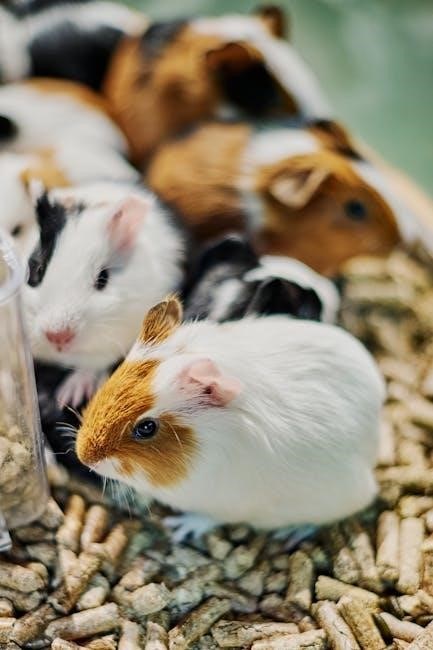
guinea pig food chart pdf
A balanced diet is essential for guinea pigs‚ focusing on hay‚ fresh vegetables‚ fruits‚ and limited pellets. The Guinea Pig Food Chart PDF guides owners on safe‚ healthy options‚ ensuring proper portion sizes and frequency to avoid health risks like obesity or bladder stones. Daily essentials include high vitamin C intake and fresh water‚ promoting overall well-being and longevity.
1.1 Importance of a Balanced Diet for Guinea Pigs
A balanced diet is crucial for maintaining guinea pigs’ health‚ preventing illnesses‚ and ensuring longevity. Guinea pigs are herbivores‚ requiring a diet rich in fiber‚ vitamins‚ and minerals. Hay should make up 80% of their intake‚ aiding digestion and tooth health. Fresh vegetables and fruits provide essential nutrients like vitamin C‚ which guinea pigs cannot produce naturally. A lack of vitamin C can lead to severe health issues‚ such as scurvy. Overfeeding or improper food choices can result in obesity‚ bladder stones‚ or digestive problems. The Guinea Pig Food Chart PDF serves as a helpful guide‚ outlining safe and harmful foods‚ portion sizes‚ and feeding frequencies. It emphasizes avoiding high-calcium foods without balancing them with low-calcium options. A well-planned diet ensures guinea pigs thrive‚ staying active and healthy throughout their lives.
1.2 Overview of the Guinea Pig Food Chart PDF
The Guinea Pig Food Chart PDF is a comprehensive guide designed to help owners provide a nutritious and balanced diet for their pets. It categorizes foods into safe and unsafe options‚ highlighting portion sizes and feeding frequencies. The chart emphasizes the importance of variety‚ ensuring guinea pigs receive essential nutrients like vitamin C‚ fiber‚ and minerals. It also warns against overfeeding and lists high-calcium foods that should be balanced with low-calcium alternatives to prevent health issues like bladder stones. The PDF is a practical tool for meal planning‚ offering a clear and organized approach to feeding. It helps owners avoid harmful foods and provides tips for introducing new foods gradually to prevent digestive upset. This resource is invaluable for ensuring guinea pigs thrive with a well-rounded and nutritious diet.

Understanding Guinea Pig Dietary Needs
Guinea pigs require a diet rich in hay‚ fresh vegetables‚ and limited fruits. High vitamin C intake is crucial‚ while calcium balance prevents bladder stones. Proper portion sizes ensure optimal health.
2.1 Role of Hay in Guinea Pig Diets
Hay is the cornerstone of a guinea pig’s diet‚ making up approximately 80% of their daily intake. It provides essential fiber‚ promoting healthy digestion and preventing issues like obesity and dental problems. Grass hay‚ such as Timothy hay‚ is highly recommended due to its balanced calcium and protein content. Alfalfa hay‚ while nutritious‚ should be avoided as it can lead to health complications if fed regularly. Fresh hay should always be available to ensure guinea pigs stay satisfied and healthy. Avoiding moldy or stale hay is crucial to prevent respiratory issues. Hay also helps wear down their teeth naturally‚ keeping them trimmed and preventing overgrowth. A constant supply of high-quality hay is vital for maintaining overall well-being and longevity in guinea pigs.
2.2 Importance of Fresh Vegetables
Fresh vegetables are a vital component of a guinea pig’s diet‚ providing essential vitamins‚ minerals‚ and fiber. They should be fed daily‚ with a recommended intake of at least one cup per guinea pig. Vegetables like leafy greens‚ such as kale‚ spinach‚ and lettuce‚ are rich in nutrients and help maintain overall health. Cruciferous vegetables‚ like broccoli and cauliflower‚ also offer numerous benefits. Fresh vegetables are a primary source of vitamin C‚ which is crucial for guinea pigs since they cannot produce it themselves. A varied selection of vegetables ensures a broad spectrum of nutrients‚ promoting healthy digestion and preventing deficiencies. However‚ portion control is key to avoid overfeeding‚ which can lead to weight gain and other health issues. Regularly rotating vegetables helps keep the diet interesting and nutritionally balanced for guinea pigs.
2.3 Role of Fruits in Guinea Pig Diets
Fruits play a significant role in guinea pig diets as a tasty and nutritious treat. They provide essential vitamins‚ antioxidants‚ and fiber‚ which support overall health. Guinea pigs enjoy fruits like strawberries‚ blueberries‚ and kiwis‚ which are rich in vitamin C‚ a crucial nutrient they cannot produce on their own. Fruits should be offered in moderation‚ ideally 1-2 tablespoons per guinea pig daily‚ to avoid overloading their diet with sugar. Overfeeding can lead to weight gain and health issues. Fresh‚ ripe fruits are best‚ while dried or canned options should be avoided due to added sugars. Introducing fruits gradually helps prevent digestive upset. The Guinea Pig Food Chart PDF can guide owners on safe‚ appropriate fruit choices and portion sizes for a balanced diet.
2.4 Guinea Pig Pellets and Their Importance
Guinea pig pellets are a concentrated source of essential nutrients‚ including vitamin C‚ which is vital for their health. They should be specifically formulated for guinea pigs and used as a supplement to their diet‚ making up about 5-10% of their daily intake. High-quality pellets provide balanced nutrition‚ ensuring guinea pigs receive necessary vitamins and minerals. However‚ they should not replace hay or fresh vegetables‚ as over-reliance on pellets can lead to health issues. It’s important to choose pellets without added sugars or artificial ingredients and to store them properly to maintain freshness. The Guinea Pig Food Chart PDF can help owners select the best pellets and understand their role in a well-rounded diet. Always opt for fresh batches‚ as vitamin C degrades over time‚ especially once opened.
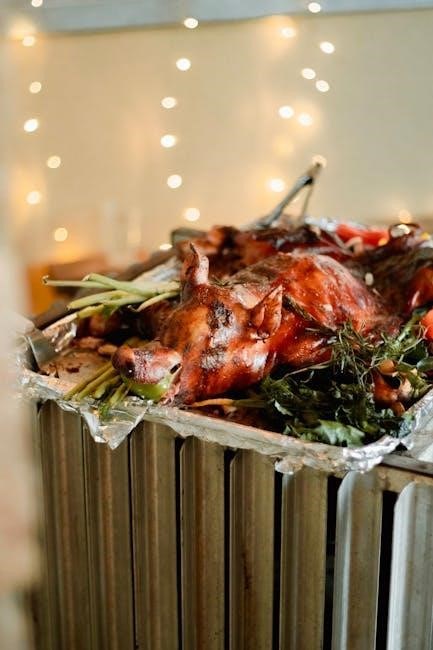
Daily Diet Guide for Guinea Pigs
A guinea pig’s daily diet should consist of 80% hay‚ 10-15% fresh vegetables‚ and 5-10% high-quality pellets. Fresh water must always be available. This balanced approach ensures optimal health and prevents nutritional deficiencies.
3.1 Recommended Hay Intake
Hay should make up approximately 80% of a guinea pig’s diet‚ ensuring unlimited access daily. High-quality grass hay‚ such as timothy or orchard grass‚ is essential for maintaining digestive health. Alfalfa hay should be avoided due to its high calcium and protein content‚ which can lead to health issues. Offering a variety of hays helps prevent boredom and ensures a balanced intake of nutrients. Fresh hay should be provided daily to keep your guinea pig active and healthy. Regularly replacing stale or soiled hay is crucial to prevent contamination. Always check the Guinea Pig Food Chart PDF for specific hay recommendations tailored to your pet’s needs.
3.2 Vegetable Portion Sizes
Guinea pigs require at least one cup of fresh vegetables daily‚ with portion sizes adjusted based on their size and weight. Leafy greens like kale‚ spinach‚ and lettuce should be staples‚ while colorful vegetables such as bell peppers and carrots can be added in moderation. Avoid overfeeding high-calcium vegetables like collard greens‚ as they may lead to bladder stones. Balance high-calcium options with low-calcium alternatives like cucumbers or zucchini. Introduce new vegetables gradually to prevent digestive upset. Refer to the Guinea Pig Food Chart PDF for specific portion guidelines and safe vegetable options. Ensuring variety and proper portion control is key to maintaining a healthy‚ balanced diet for your guinea pig.
3.3 Fruit Portion Sizes
Fruits should be given to guinea pigs in moderation due to their high sugar content. Offer 1-2 tablespoons of fresh fruit daily‚ adjusting based on your guinea pig’s size. High-sugar fruits like berries should be limited to 1-2 times weekly‚ while lower-sugar options like apples or melons can be more frequent. Avoid overfeeding‚ as excessive sugar can lead to weight gain and health issues. Introduce new fruits slowly to prevent digestive upset. Use the Guinea Pig Food Chart PDF to identify safe fruits and their recommended serving sizes. Always remove seeds and rinds‚ as they can be harmful. Fresh fruits should complement‚ not replace‚ the primary diet of hay‚ vegetables‚ and pellets. Ensure variety and balance to meet your guinea pig’s nutritional needs without risking overfeeding.
3.4 Pellet Feeding Guidelines
Guinea pig pellets should make up 5-10% of their daily diet. Choose high-quality‚ vitamin C-enriched pellets specifically formulated for guinea pigs. Avoid alfalfa-based pellets for adults‚ as they are too rich. Offer 1-2 tablespoons of pellets per guinea pig daily‚ depending on size and activity level. Ensure pellets are fresh‚ as vitamin C degrades over time. Use pellets within 90 days of opening to maximize nutritional value. Do not overfeed‚ as pellets are calorie-dense and can lead to obesity. Always provide unlimited hay and fresh vegetables alongside pellets. Refer to the Guinea Pig Food Chart PDF for portion guides and to ensure a balanced diet. Pellets should complement‚ not replace‚ fresh foods in your guinea pig’s diet. Adjust pellet amounts based on individual needs and health conditions.
Vitamin C in Guinea Pig Diets
Guinea pigs require a constant supply of vitamin C to prevent scurvy. Include fresh‚ vitamin C-rich vegetables like kale or bell peppers daily. Pellets often contain vitamin C but lose potency over time‚ so fresh foods are essential for meeting daily needs.
4.1 Why Vitamin C is Crucial for Guinea Pigs
Vitamin C is essential for guinea pigs as they cannot synthesize it themselves. It plays a critical role in maintaining their immune system‚ skin health‚ and connective tissues. A deficiency can lead to scurvy‚ causing symptoms like lethargy‚ joint pain‚ and poor wound healing. Fresh vegetables rich in vitamin C‚ such as kale‚ broccoli‚ and bell peppers‚ should be provided daily to meet their needs. Without adequate vitamin C‚ guinea pigs are at risk of severe health complications‚ making it a cornerstone of their diet. The Guinea Pig Food Chart PDF highlights high vitamin C foods to ensure owners can easily incorporate them into their pets’ meals.
4.2 High Vitamin C Foods for Guinea Pigs
Guinea pigs require a steady supply of vitamin C-rich foods to stay healthy. Leafy greens like kale‚ broccoli‚ spinach‚ and mustard greens are excellent sources. Bell peppers‚ strawberries‚ and citrus fruits such as oranges and kiwis also provide ample vitamin C. These foods help prevent scurvy and support overall well-being. The Guinea Pig Food Chart PDF lists high vitamin C options‚ making it easier for owners to plan balanced meals. Incorporating variety ensures guinea pigs receive adequate amounts daily. Always choose fresh‚ organic options when possible to maximize nutrient intake and keep your guinea pigs thriving.
4.3 Ensuring Adequate Vitamin C Intake
Ensuring guinea pigs get enough vitamin C is crucial for their health‚ as they cannot produce it naturally. Fresh vegetables and fruits high in vitamin C should be provided daily to prevent scurvy. Foods like kale‚ strawberries‚ and bell peppers are excellent choices. Guinea pigs need at least one cup of fresh veggies per day‚ with at least one high vitamin C option included. The Guinea Pig Food Chart PDF helps identify these foods and portion sizes. Rotate varieties to keep meals interesting and nutrient-rich. Avoid relying solely on pellets‚ as vitamin C degrades over time. Always offer fresh water to support digestion and nutrient absorption. Monitoring intake and using the chart ensures your guinea pig stays healthy and thrives. Consistency is key to maintaining adequate vitamin C levels.
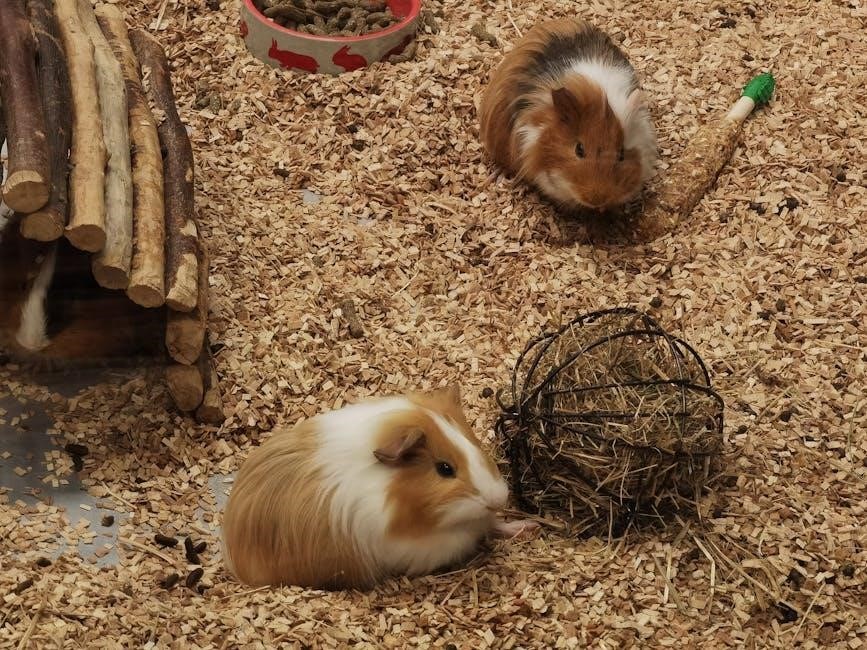
Calcium Balance in Guinea Pig Diets
Balance calcium intake to prevent bladder stones. High-calcium foods should be offset with mid to low-calcium options. The Guinea Pig Food Chart PDF provides categorized food lists for safe feeding.
5.1 High Calcium Foods to Balance
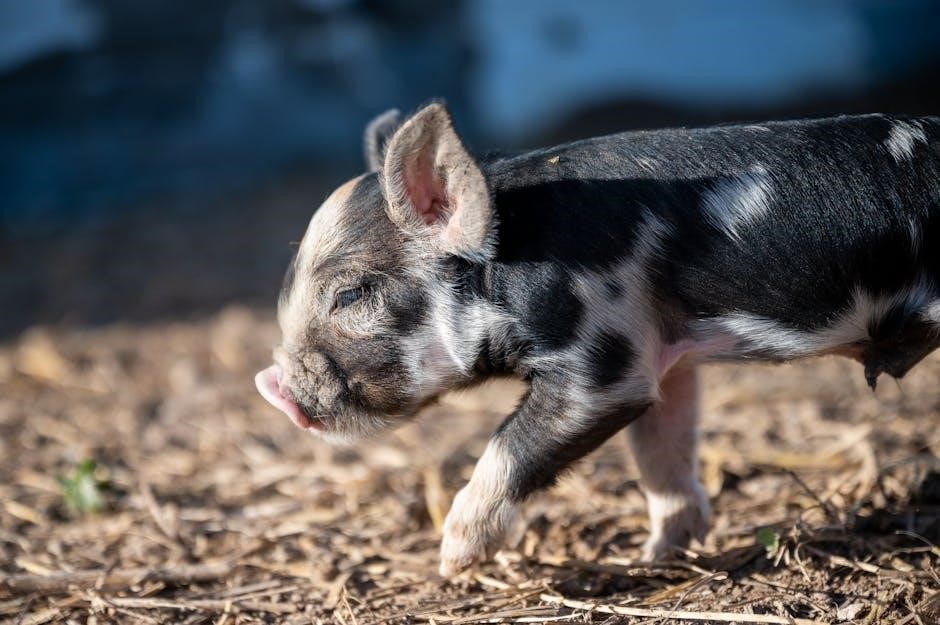
High-calcium foods‚ such as kale‚ collard greens‚ mustard greens‚ and dandelion greens‚ should be fed in moderation to prevent bladder stones. These foods are nutritious but can lead to calcium overload if overfed. Guinea pigs require a balanced diet‚ so high-calcium vegetables should be offset with mid to low-calcium options. For example‚ kale and collard greens are high in calcium and should be limited to 1-2 times a week. Overconsumption can cause mineral buildup‚ leading to health issues. Always introduce these foods gradually and monitor your guinea pig’s response. Consulting a food chart or vet can help determine safe portion sizes and ensure a well-rounded diet. Balancing high-calcium foods with lower-calcium alternatives is key to maintaining your guinea pig’s urinary and overall health.
5.2 Medium Calcium Foods
Medium calcium foods‚ such as spinach‚ Swiss chard‚ and beet greens‚ offer essential nutrients while maintaining a moderate calcium level. These vegetables can be fed 2-3 times weekly to provide variety without risking calcium overload. They are rich in vitamins and minerals but should be balanced with low-calcium options to prevent bladder stone formation. For example‚ spinach is a medium-calcium food that can be given 2-3 times a week‚ while Swiss chard and beet greens can be introduced similarly. These foods are nutritious but should not dominate the diet. Rotate medium-calcium vegetables to ensure a balanced intake and prevent overexposure to calcium. Always refer to a food chart to confirm portion sizes and calcium levels‚ ensuring your guinea pig’s diet remains well-rounded and safe.
5.3 Low Calcium Foods
Low calcium foods are ideal for balancing guinea pig diets‚ as they help prevent bladder stones. Examples include leafy greens like lettuce‚ kale‚ and zucchini. These foods are rich in vitamins and minerals but contain minimal calcium‚ making them a great addition to daily meals. Guinea pigs can safely enjoy low-calcium vegetables daily‚ as they provide essential nutrients without overloading their system. For instance‚ lettuce is a low-calcium option that can be fed regularly‚ while zucchini offers hydration and fiber. These foods are crucial for maintaining a balanced diet and preventing health complications. Always refer to a food chart to identify low-calcium options and ensure variety in your guinea pig’s meals for optimal health and well-being.

Avoiding Common Health Risks
Guinea pigs are prone to bladder stones from excess calcium and obesity from overfeeding. Ensuring a balanced diet and avoiding high-starch foods helps prevent these risks. Regular vet check-ups are crucial for early detection of health issues‚ while providing fresh water and vitamin C-rich foods can prevent scurvy and other deficiencies. Monitoring food intake and maintaining a clean environment also play significant roles in keeping guinea pigs healthy and thriving.
6.1 Foods to Avoid for Guinea Pigs

Guinea pigs should avoid high-calcium foods like collard greens and spinach‚ which can lead to bladder stones. Alfalfa hay is too rich and should be limited. Processed foods‚ meat‚ and dairy are unsuitable. Avoid high-sugar foods like chocolate and candies. Certain vegetables‚ such as rhubarb and onions‚ are toxic. Guinea pigs are herbivores and thrive on plant-based diets. Fresh‚ nutrient-rich foods are essential‚ but harmful items must be excluded to prevent health issues. Always consult a Guinea Pig Food Chart PDF for safe feeding options to ensure a healthy‚ balanced diet.
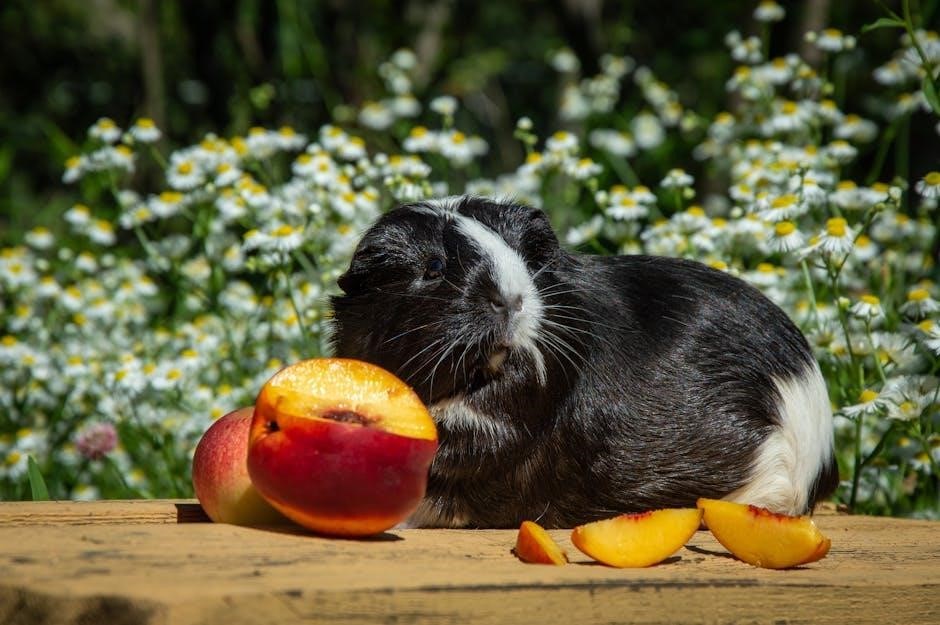
6.2 Preventing Bladder Stones
Preventing bladder stones in guinea pigs requires careful dietary management. High-calcium foods should be balanced with low-to-medium calcium options to avoid mineral buildup. The Guinea Pig Food Chart PDF categorizes foods by calcium levels‚ helping owners make informed choices. Ensuring access to fresh water is crucial‚ as hydration helps dilute urine and reduce stone formation risk. Avoiding excessive oxalate-rich foods like spinach and limiting processed treats can also help. Monitoring for symptoms like difficulty urinating or blood in urine is vital. If such signs appear‚ consult a vet promptly. A balanced diet and proper hydration are key to maintaining urinary health and preventing bladder stones in guinea pigs.
6.3 Avoiding Overfeeding
Avoiding overfeeding is crucial for maintaining guinea pigs’ health. Guinea pigs have a tendency to overeat‚ which can lead to obesity and related health issues. Portion control is essential‚ especially for high-calorie foods like pellets and fruits. The Guinea Pig Food Chart PDF provides clear guidelines on appropriate serving sizes to prevent overfeeding. Monitoring your guinea pig’s weight and adjusting their diet accordingly is also important. Overfeeding can result in digestive problems‚ lethargy‚ and an increased risk of health complications. Ensuring a balanced diet with plenty of fresh hay‚ limited pellets‚ and moderate amounts of fresh vegetables and fruits is key to preventing overfeeding and promoting overall well-being. Always consult the chart to avoid giving too much of any food group and maintain a healthy‚ balanced diet for your guinea pig.
Fresh Fruits for Guinea Pigs
Avoiding overfeeding is vital to prevent obesity and related health issues in guinea pigs. Signs of overfeeding include weight gain and lethargy. Stick to portion-sized servings of fruits and pellets‚ as these are high in calories. The Guinea Pig Food Chart PDF recommends limiting treats and ensuring a balanced diet. Overfeeding can lead to digestive problems and bladder stones. Monitor their intake to maintain a healthy weight. Ensure fresh hay and vegetables dominate their diet‚ while fruits and pellets are given in moderation. A well-regulated feeding schedule‚ guided by the chart‚ helps prevent overfeeding and keeps your guinea pig active and healthy.
7.1 Safe Fruits for Guinea Pigs
Fresh fruits can be a delicious and nutritious addition to a guinea pig’s diet when chosen wisely. Safe options include apples‚ bananas‚ berries (like strawberries‚ blueberries‚ and raspberries)‚ and melons. Fruits high in vitamin C‚ such as kiwis and oranges‚ are particularly beneficial since guinea pigs cannot produce this essential nutrient themselves. However‚ fruits should be given in moderation due to their natural sugar content. The Guinea Pig Food Chart PDF recommends limiting fruit portions to 1-2 tablespoons per day to avoid overfeeding. Always remove seeds‚ pits‚ and rinds‚ as these can pose health risks. Introducing fruits gradually ensures your guinea pig can tolerate them without digestive issues. A varied selection of safe fruits helps maintain a balanced diet and keeps your guinea pig happy and healthy.
7.2 Frequency of Feeding Fruits

Fruits should be fed to guinea pigs in moderation and as an occasional treat rather than a staple. The Guinea Pig Food Chart PDF recommends limiting fruit intake to 1-2 tablespoons per day. Overfeeding can lead to weight gain and digestive issues due to the high sugar content in many fruits. High-sugar fruits‚ such as bananas and grapes‚ should be given sparingly‚ while lower-sugar options like berries can be offered more frequently. It’s also important to rotate fruits daily to ensure variety and prevent boredom. Fresh fruits should never replace hay or vegetables‚ which should make up the bulk of their diet. Always introduce new fruits gradually to monitor for any adverse reactions and adjust the feeding schedule accordingly to maintain a balanced diet. The key is to provide fruits as a supplement‚ not a substitute‚ for their overall nutritional needs;
7.3 Tips for Introducing New Fruits
Introducing new fruits to guinea pigs requires careful consideration to avoid digestive upset. Start by offering small portions of a single new fruit and monitor your guinea pig’s reaction for 24-48 hours. Consult the Guinea Pig Food Chart PDF to ensure the fruit is safe and appropriate. Gradually increase the variety by adding one new fruit at a time to prevent overwhelming their system. Always wash fruits thoroughly to remove pesticides and ensure freshness. Remove seeds‚ pits‚ and rinds‚ as they can be harmful or cause choking. Rotate fruits regularly to provide a diverse range of nutrients. If any signs of illness or discomfort appear‚ such as diarrhea or lethargy‚ discontinue the fruit immediately. Patience and observation are key to safely expanding your guinea pig’s fruit palette while maintaining a balanced diet.

Fresh Vegetables for Guinea Pigs
Fresh vegetables are vital for guinea pigs‚ providing essential vitamins‚ minerals‚ and fiber. Offer a variety daily‚ including leafy greens‚ cruciferous‚ and colorful options‚ ensuring portions match their size and needs. Consult the Guinea Pig Food Chart PDF for safe choices and proper serving sizes to maintain a balanced diet. Always introduce new vegetables gradually to prevent digestive issues. Rotate vegetables regularly to ensure a diverse nutrient intake. Avoid overfeeding to prevent obesity and other health problems. Fresh vegetables should make up 10-15% of their daily diet‚ complementing hay and pellets. Ensure all vegetables are washed thoroughly to remove pesticides and dirt.
8.1 Safe Vegetables for Guinea Pigs
Fresh vegetables are a cornerstone of a guinea pig’s diet‚ providing essential nutrients and variety. Safe options include leafy greens like spinach‚ kale‚ and lettuce‚ as well as crunchy vegetables like carrots‚ cucumbers‚ and sweet bell peppers. Herbs such as parsley‚ cilantro‚ and basil are also safe and enjoyable for guinea pigs. However‚ certain vegetables like collard greens and mustard greens should be fed sparingly due to their high calcium and oxalate content. Avoid overfeeding vegetables with high sugar content‚ such as sweet potatoes‚ to prevent obesity. Always introduce new vegetables gradually to avoid digestive upset. Ensure all vegetables are washed thoroughly to remove pesticides and dirt. A diverse vegetable selection keeps your guinea pig’s diet interesting and balanced‚ promoting overall health and well-being.
8.2 Frequency of Feeding Vegetables
Guinea pigs require a steady supply of fresh vegetables daily to stay healthy. Aim to provide at least 1-2 cups of fresh vegetables per guinea pig each day‚ adjusting for their size and age. Offer a variety of vegetables to ensure a broad spectrum of nutrients and prevent boredom. Leafy greens like spinach‚ kale‚ and lettuce can be fed daily‚ while higher-sugar vegetables like carrots and sweet bell peppers should be given in moderation (1-2 times weekly). Rotate vegetables every few days to avoid overfeeding any single type and to maintain a balanced diet. Introduce new vegetables gradually to prevent digestive upset. Ensure vegetables are fresh‚ washed‚ and free of pesticides to maximize their nutritional value. Avoid overfeeding‚ as guinea pigs can easily become overweight‚ leading to health issues. Always balance high-calcium vegetables with lower-calcium options to prevent bladder stones.
8.3 Tips for Introducing New Vegetables
When introducing new vegetables to your guinea pig’s diet‚ start with small portions to monitor their tolerance. Gradually increase the quantity over a few days to prevent digestive upset. Offer one new vegetable at a time to identify any adverse reactions. If your guinea pig shows signs of discomfort‚ such as diarrhea or lethargy‚ remove the vegetable immediately. Always wash vegetables thoroughly to remove pesticides and dirt. Introduce a variety of vegetables to ensure a balanced diet‚ but avoid sudden changes; Rotate vegetables regularly to keep the diet interesting and nutrient-rich. This approach helps maintain a healthy digestive system and prevents boredom. Always consult a vet if unsure about specific vegetables or reactions.
Proper nutrition is vital for maintaining the health and well-being of guinea pigs. A balanced diet consisting of high-quality hay‚ fresh vegetables‚ limited fruits‚ and specialized pellets ensures they receive essential nutrients. Regularly consulting a Guinea Pig Food Chart PDF helps owners make informed decisions about safe and healthy food options. By focusing on variety‚ portion control‚ and avoiding harmful foods‚ owners can prevent common health issues like vitamin C deficiency or bladder stones. Providing fresh water and a clean environment further supports their overall health. With careful planning and attention to dietary needs‚ guinea pigs can thrive‚ leading happy and active lives. Always prioritize their specific nutritional requirements to ensure longevity and happiness for your beloved pets.